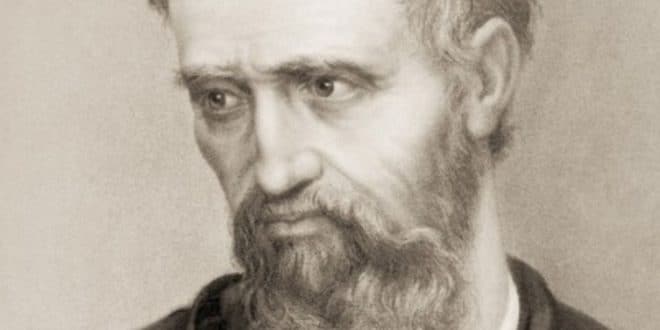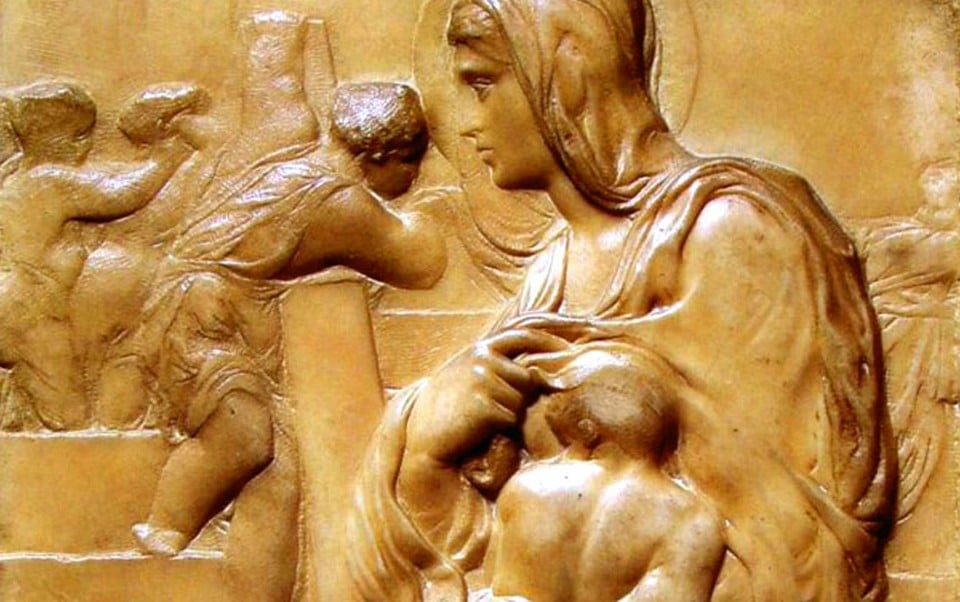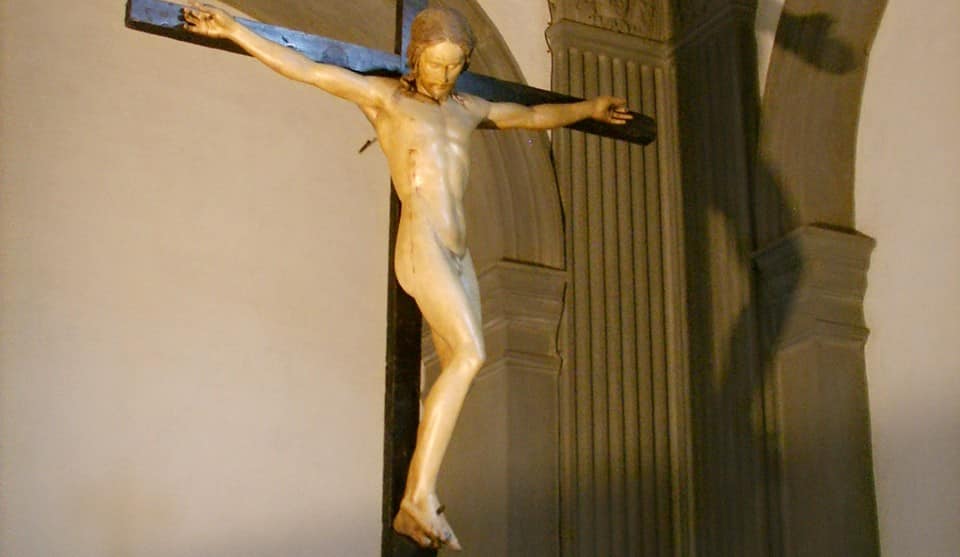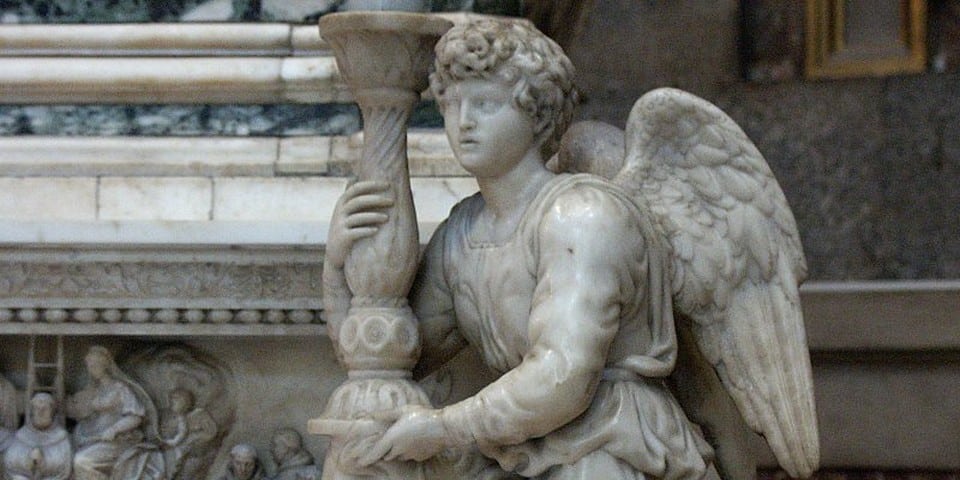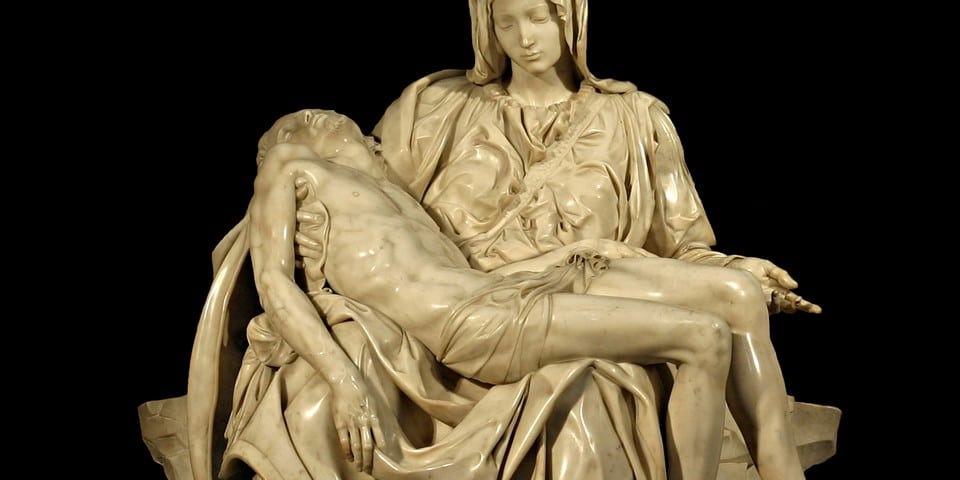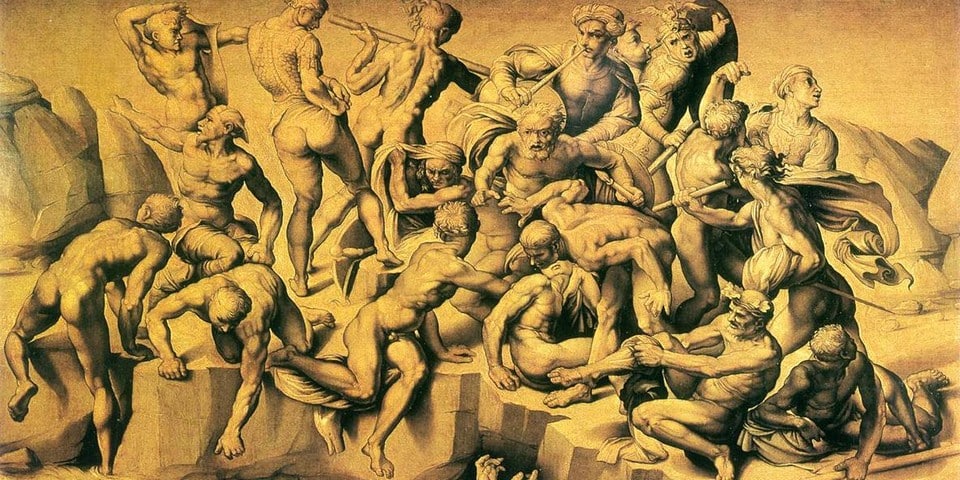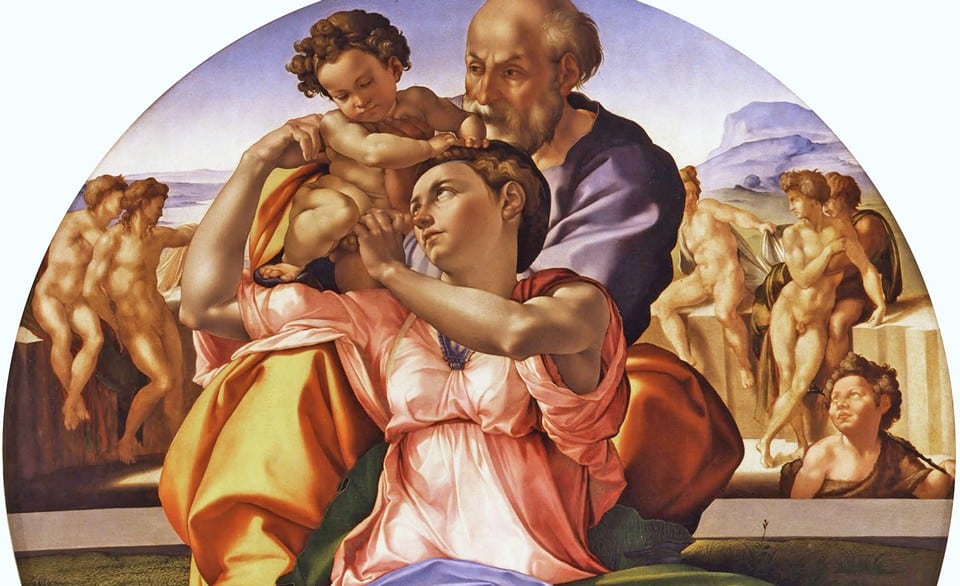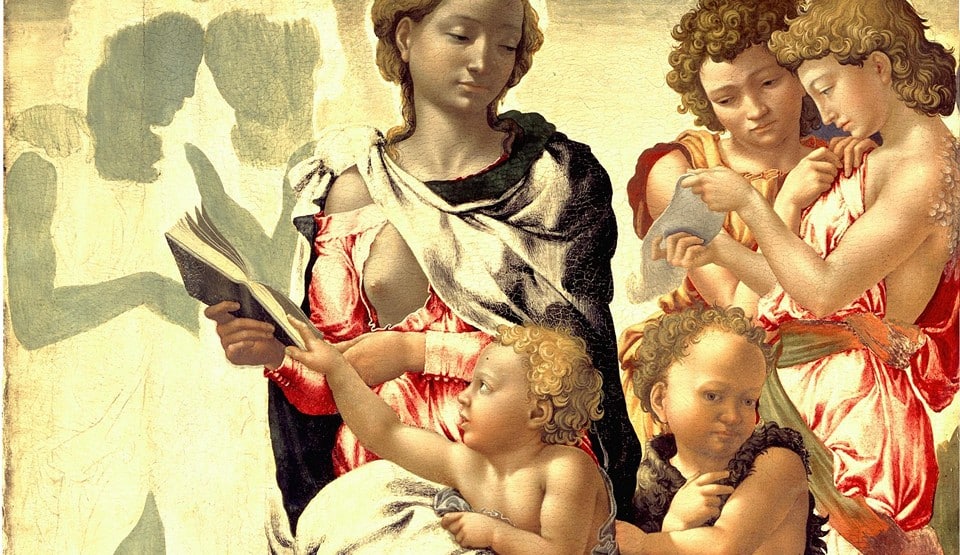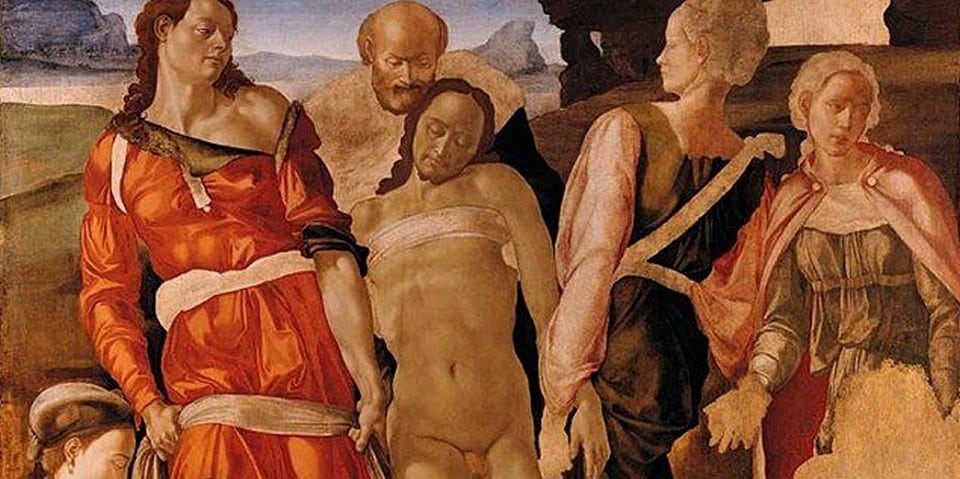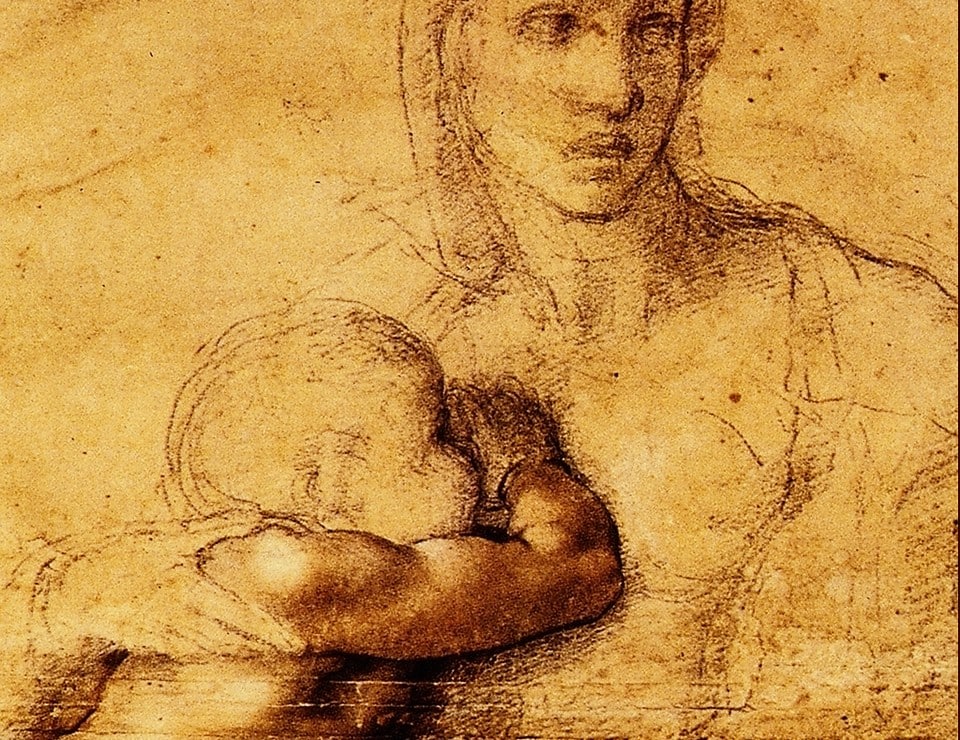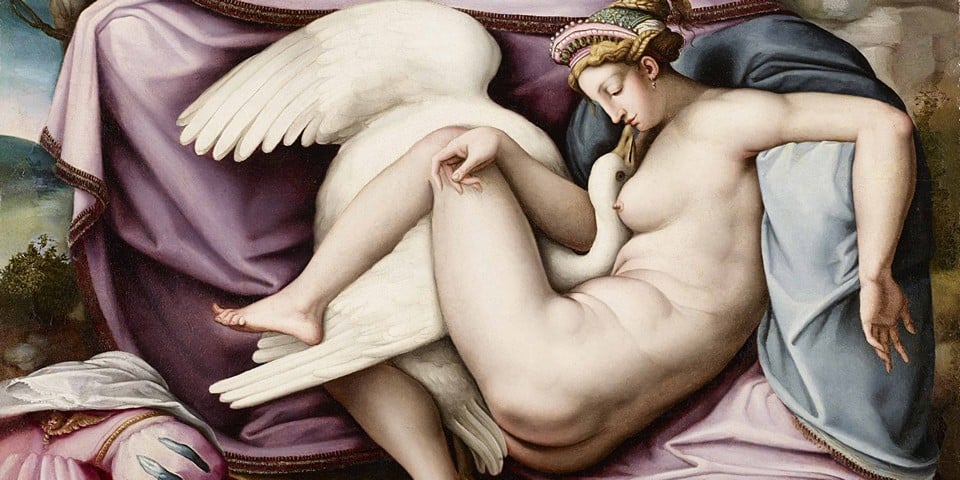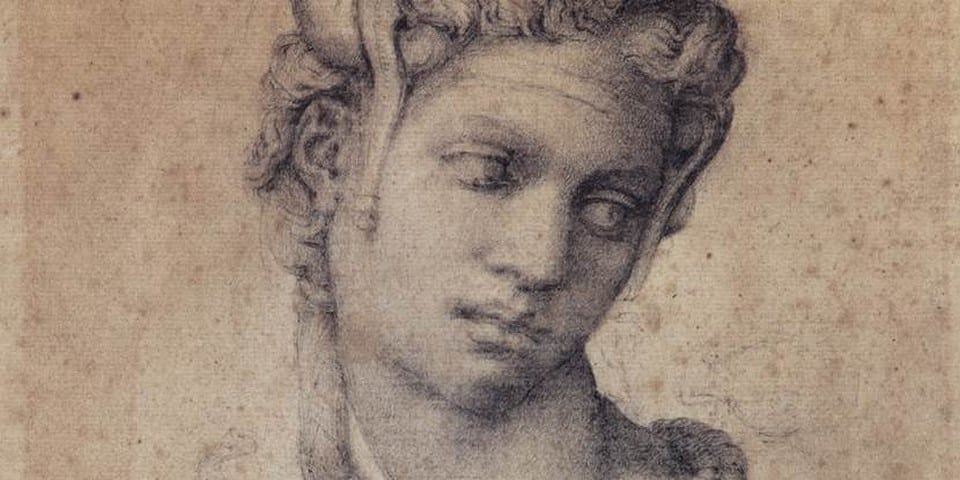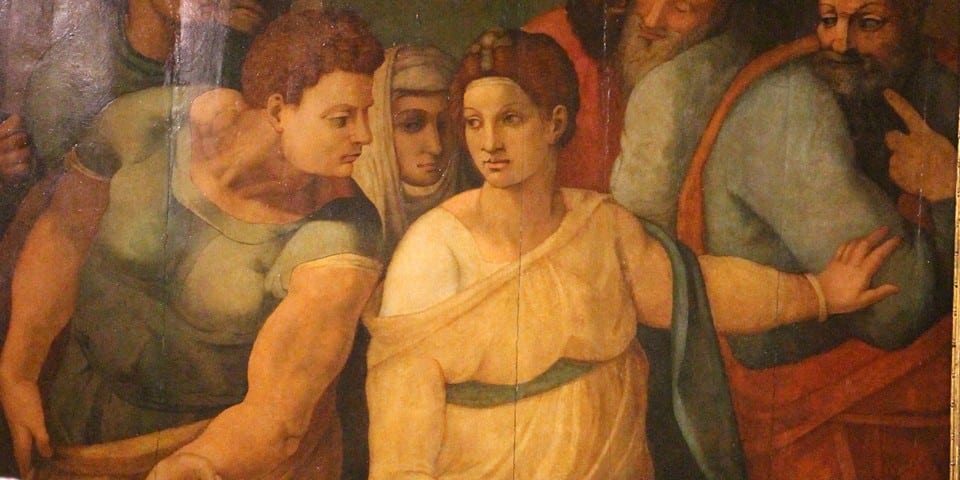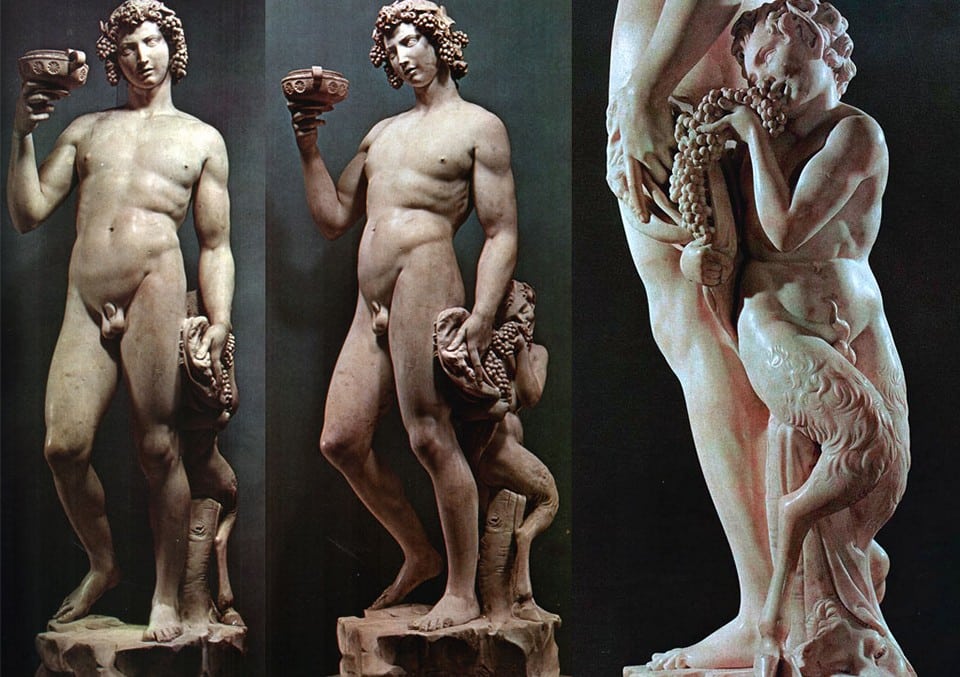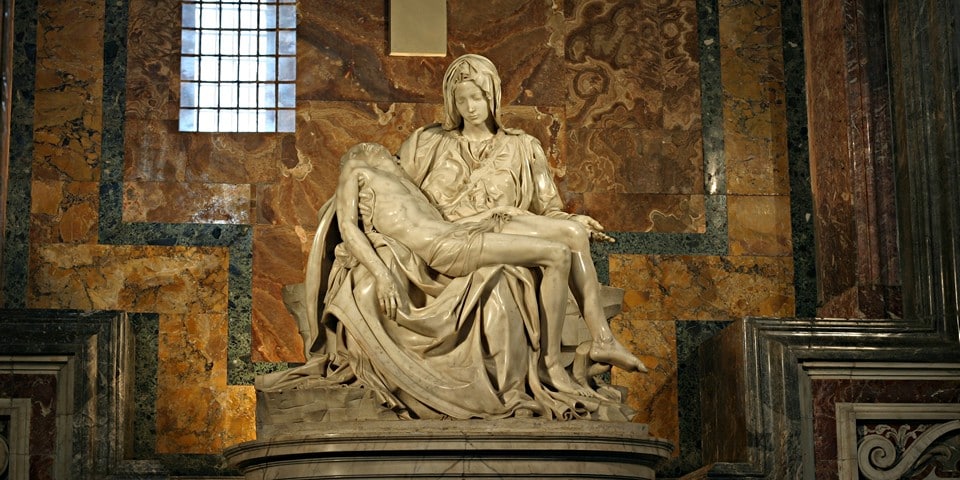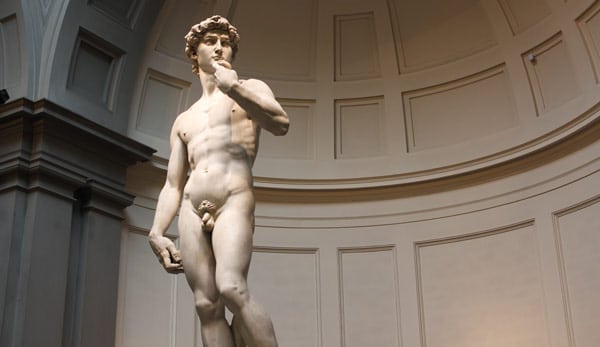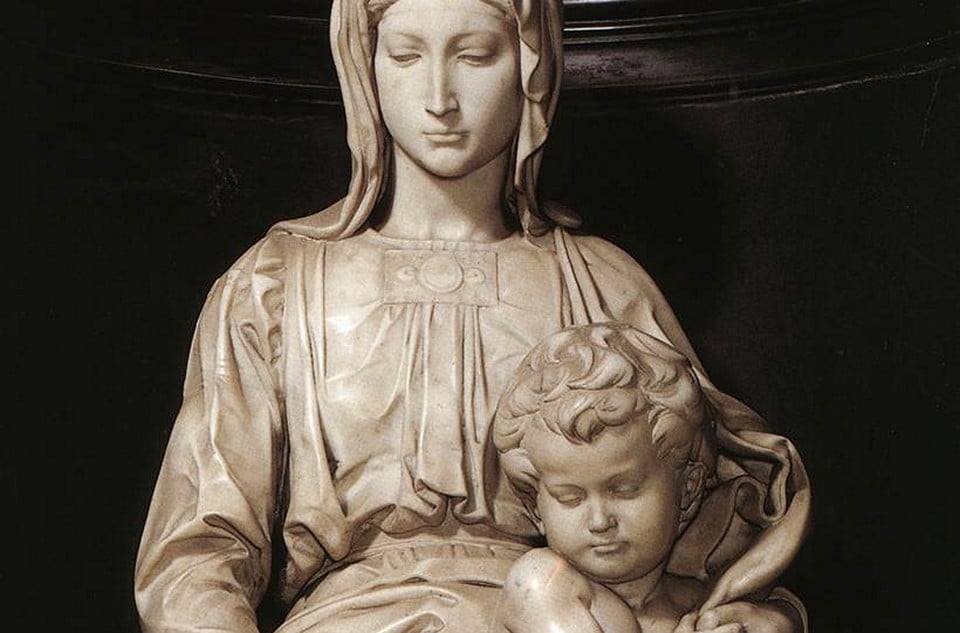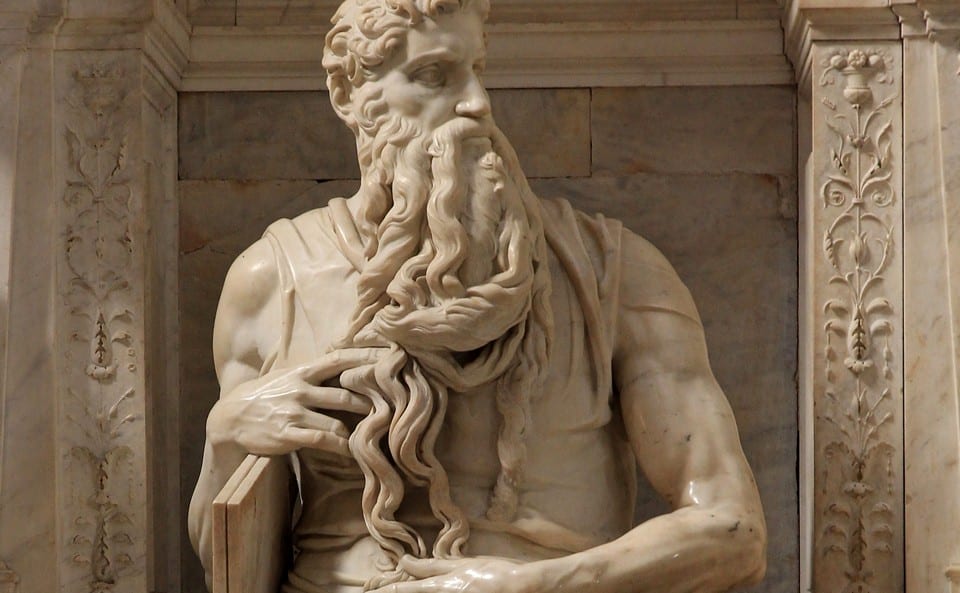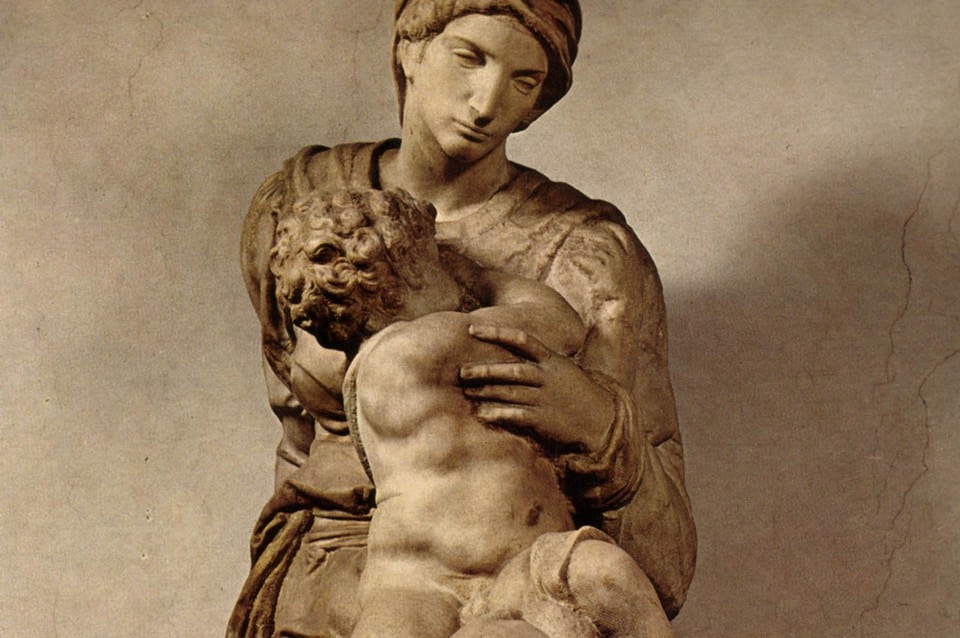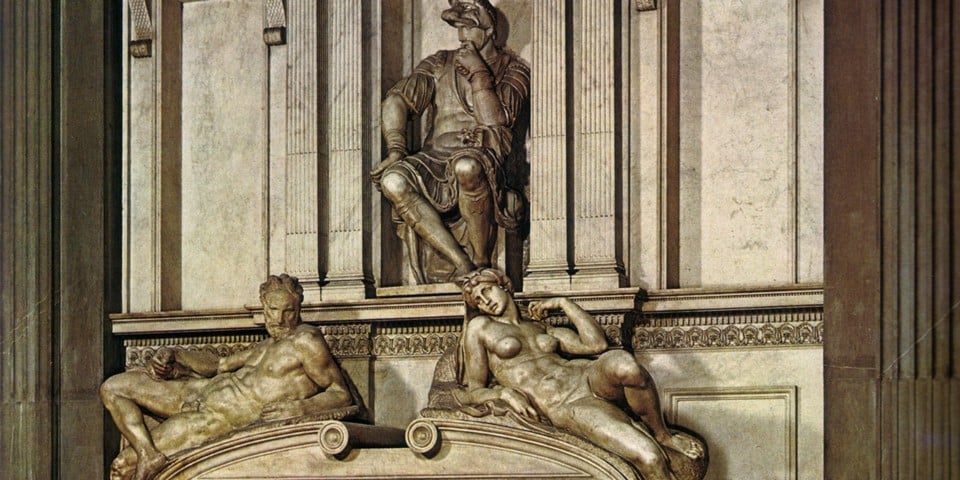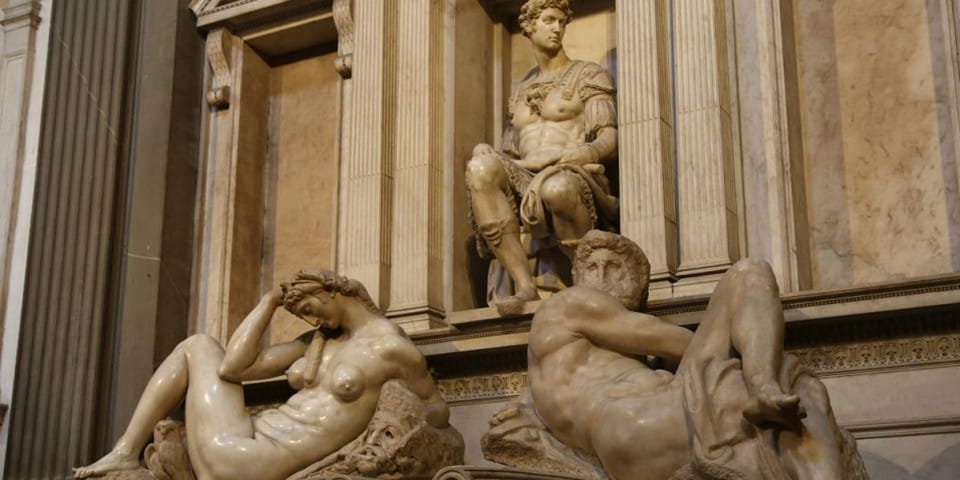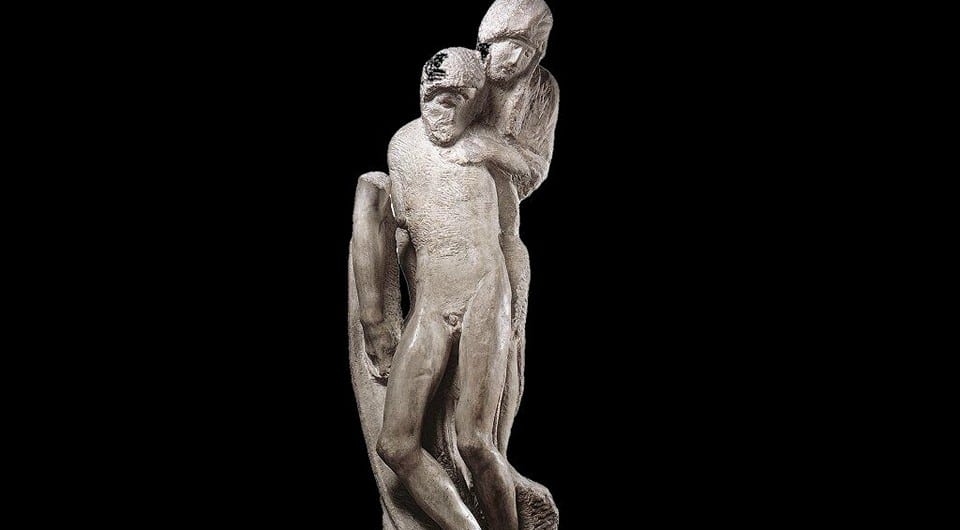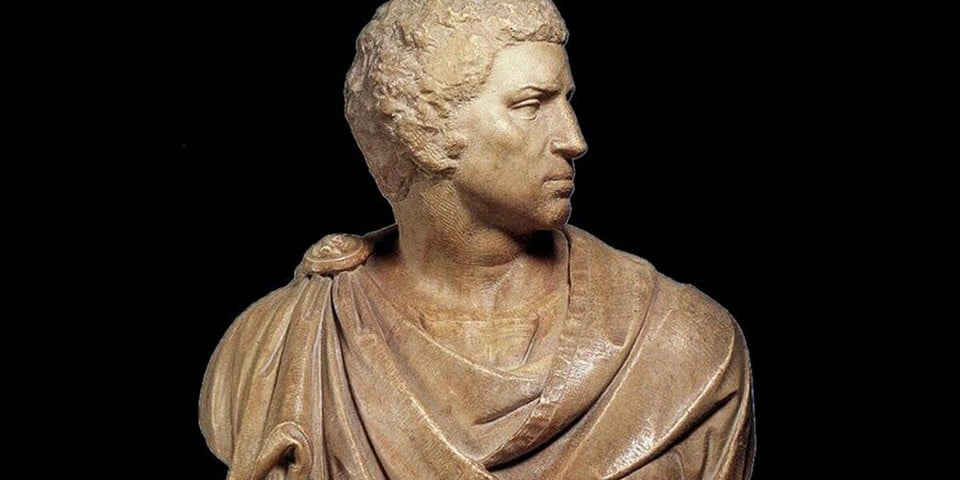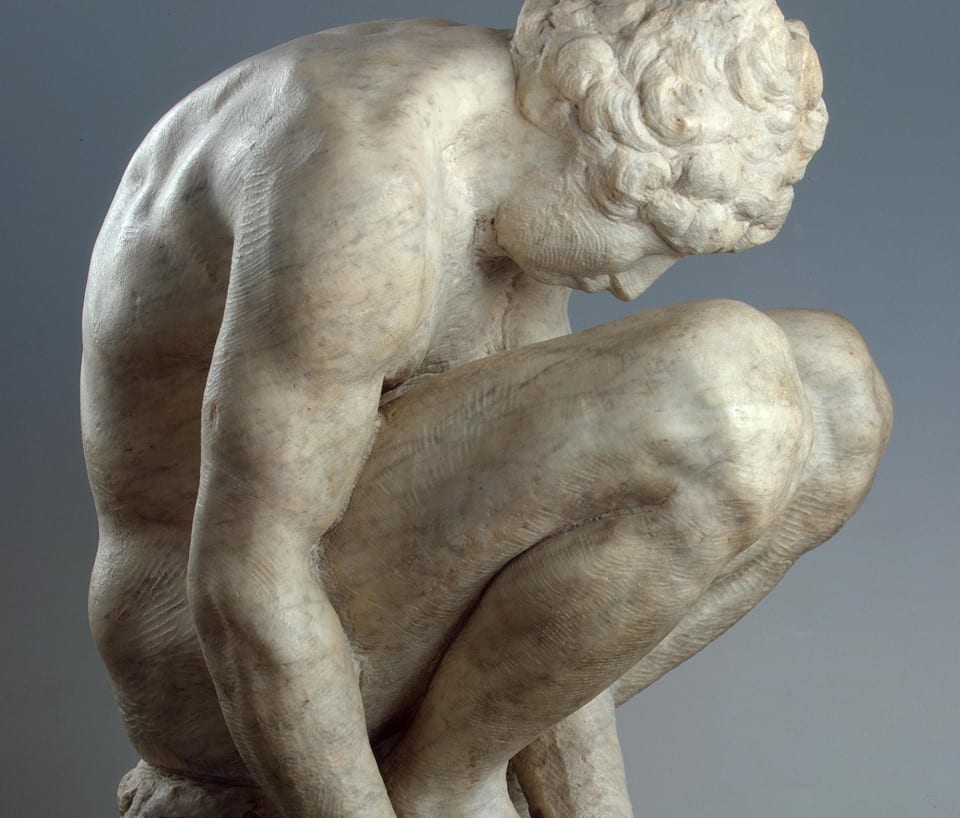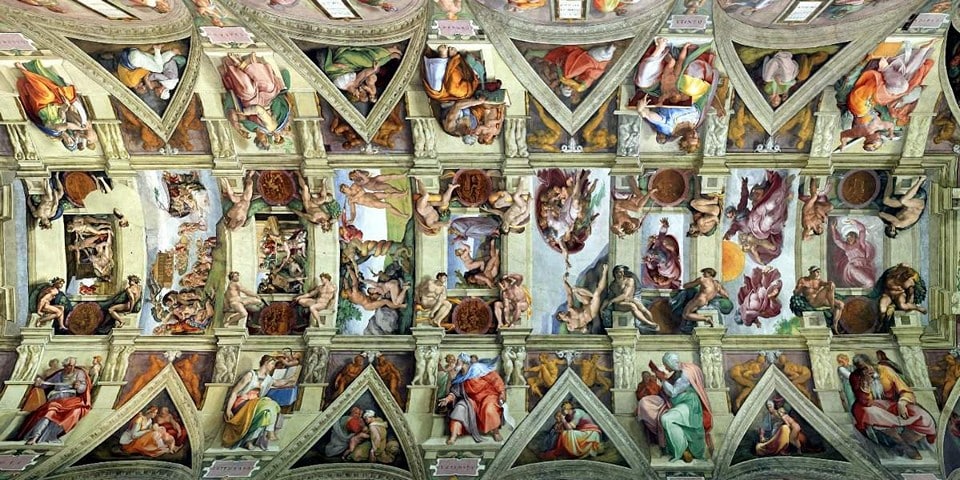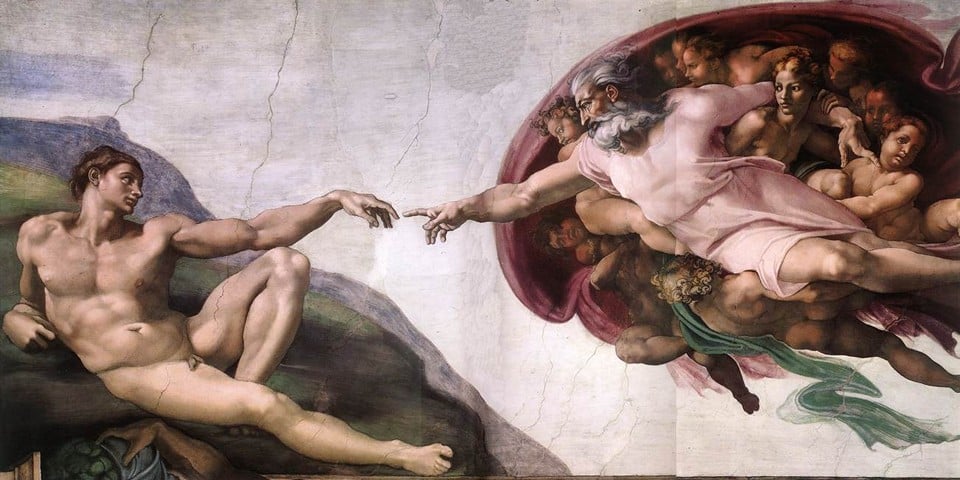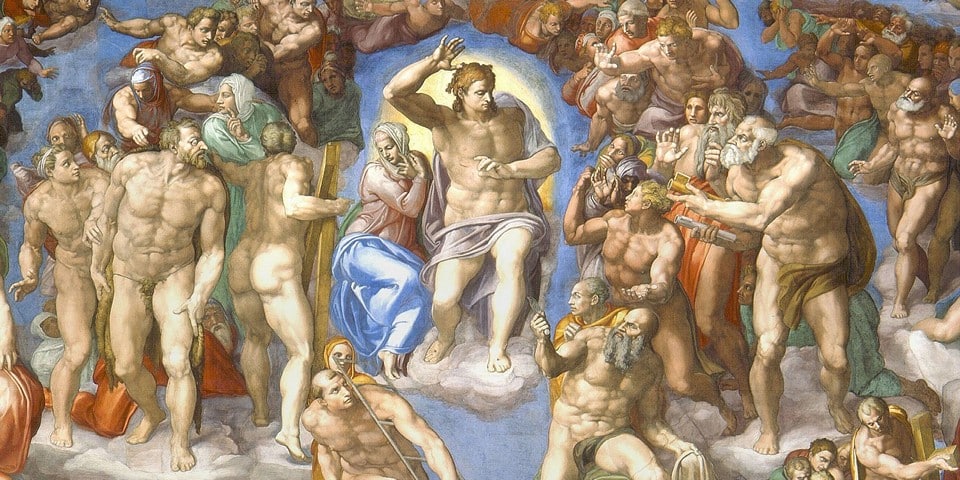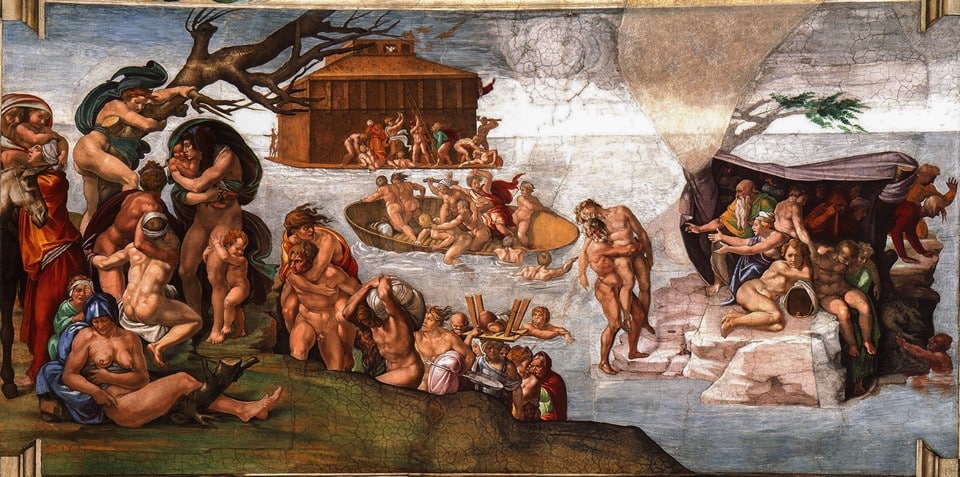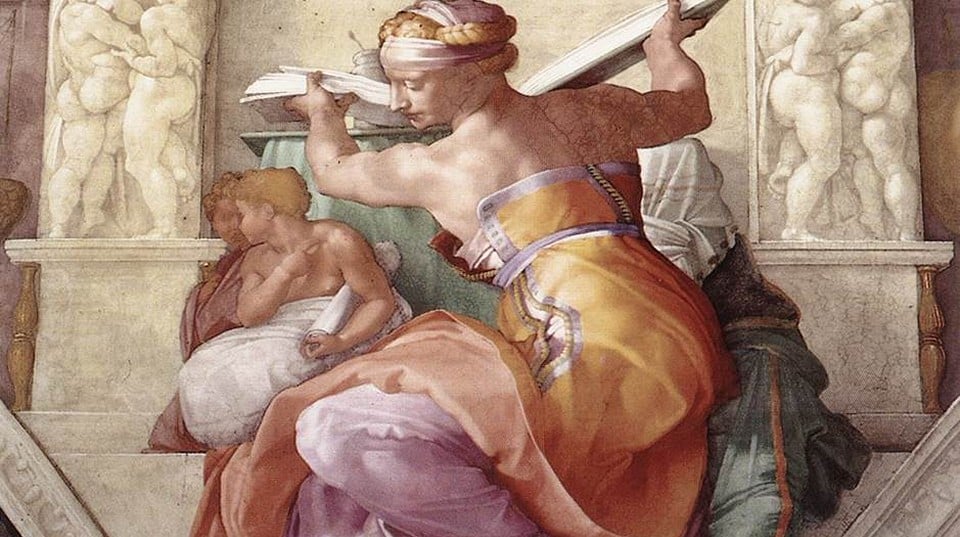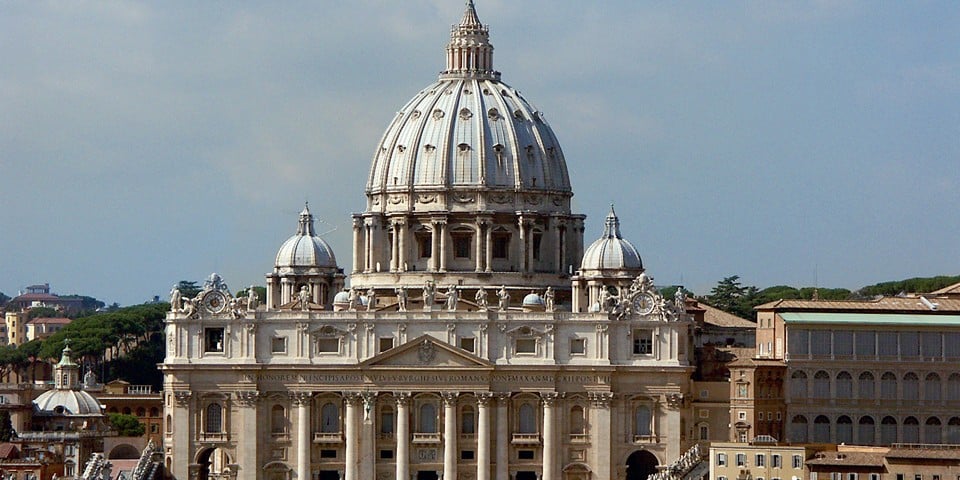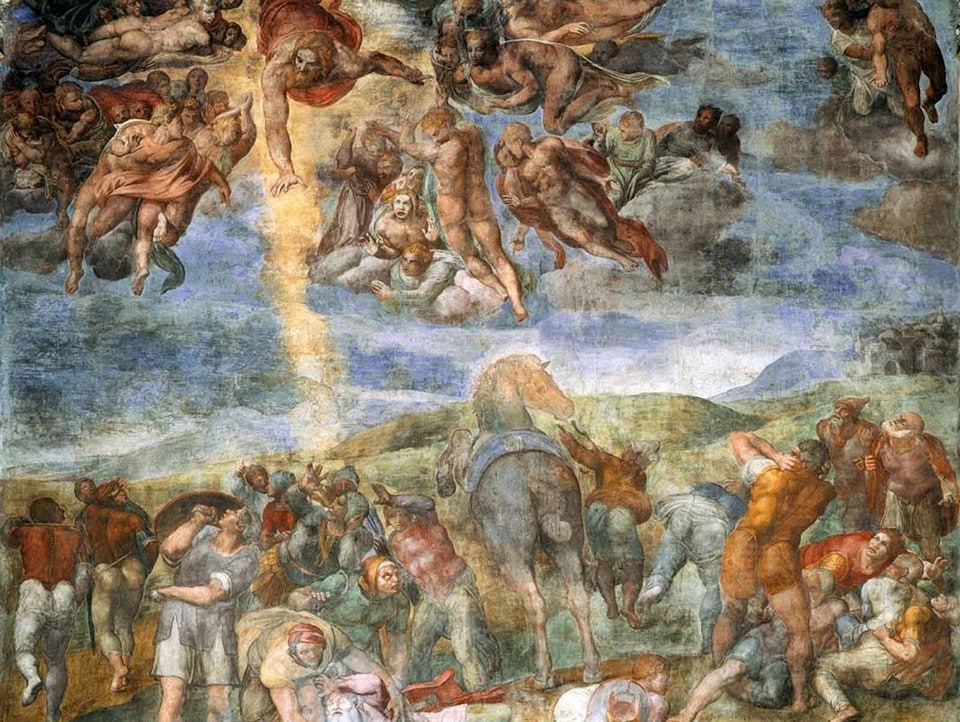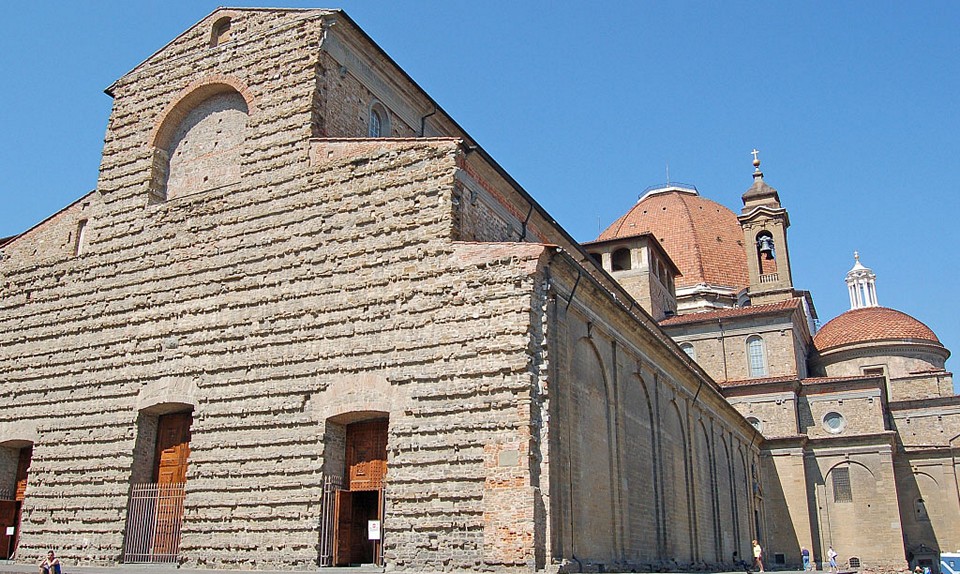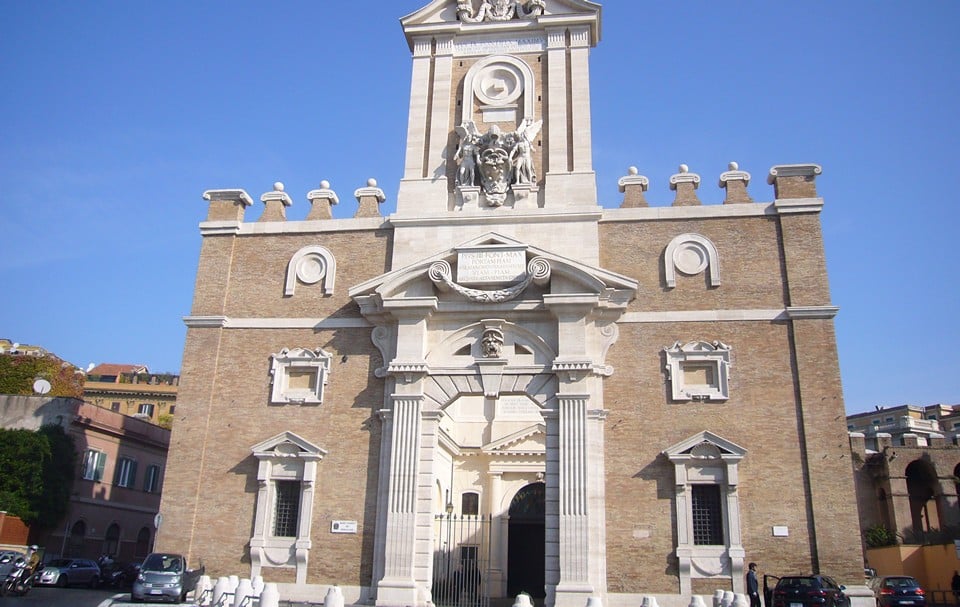Michelangelo di Lodovico di Leonardo di Buonarroti Simoni was the most famous painter from Italy, a genius of architectural and sculptural works, a thinker of the High Renaissance and early Baroque period. Nine of the 13 popes who were on the throne during Michelangelo’s time invited the master to perform works in the temples of Rome and the Vatican.
Page Contents
Biography
Michelangelo was born on a Monday morning of March 6, 1475 into the family of Lodovico Buonarroti Simoni, a banker and nobleman who had gone bankrupt, in Caprese, in Tuscany, near Arezzo, where his father was the governor of the Italian medieval administration.
Family and childhood years
Two days after his birth, on March 8, 1475, the boy was baptized in the Chiesa di San Giovanni di Caprese. Michelangelo was the 2nd child of a large family. His mother, Francesca Neri del Miniato Siena, gave birth to her firstborn son, Lionardo in 1473, Buonarroto in 1477, a fourth son, Giovansimone in 1479, and a younger one, Gismondo, in 1481. Tormented by frequent pregnancies, the woman died in 1481, barely 6 years old.
In 1485 the father of a large family married for a second time Lucrezia Ubaldini di Galliano, who was unable to have children of her own and brought up adopted boys as her own. Unable to cope with a large family, his father gave Michelangelo to the foster family Topolino in Settignano. The father of the new family worked as a stonemason, and his wife knew the child since childhood, as she was Michelangelo’s nurse. It was there that the boy began to work with clay and for the first time picked up a chisel.
In order to educate the heir, his father sent Michelangelo to the Francesco Galatea da Urbino in Florence. But his pupil turned out to be unimportant, the boy rather liked to draw, copying icons and frescoes.
His first paintings
In 1488, the young painter achieves his goal and goes to study at the studio of Domenico Ghirlandaio, where a year learns the basics of drawing techniques. During a year of study Michelangelo makes several pencil copies of famous paintings and a copy of an engraving by German painter Martin Schongauer called “Tormento di Sant’Antonio” (Tormento di Sant’Antonio).
In 1489 the young man enrolled at the Bertoldo di Giovanni art school, organized under the patronage of Lorenzo Medici, ruler of Florence. Noticing the genius of Michelangelo, the Medici took him under their patronage, helping him to develop his abilities and fulfill expensive commissions.
In 1490 Michelangelo continued his studies at the Medici court’s Academy of Humanism, where he met the philosophers Marsilio Ficino and Angelo Ambrogini, the future popes: Leo PP. During his 2 years at the Academy Michelangelo creates:
- “Madonna della scala” marble relief (“Madonna della scala”), 1492, exhibited at the Casa Buonarroti Museum in Florence (Casa Buonarroti);
- Battaglia dei centauri (Battle of the Centaurs), 1492, on display at the Casa Buonarroti in Florence. On display at Casa Buonarroti;
- Sculpture by Bertoldo di Giovanni.
On April 8, 1492 the influential patron of talent, Lorenzo de’ Medici, dies and Michelangelo decides to return to his paternal home.
In 1493, with the permission of the prior of the church of Santa Maria del Santo Spirito, he studies anatomy on corpses in the church hospital. In gratitude for this, a wooden “Crucifisso di Santo Spirito” (Crucifix of Santo Spirito) 142 cm high was made by the master craftsman for the priest, which is today displayed in the church in the side chapel.
In Bologna
In 1494 Michelangelo left Florence, not wishing to take part in Savonarola’s rebellion, and went to Bologna, where he immediately undertook a commission of 3 small figures for the tomb of San Domenico in the church of the same name, the “Chiesa di San Domenico”:
- “Angel with candelabro” (“Angelo reggicandelabro”), 1495;
- “Saint Petronio” (“San Petronio”), patron saint of Bologna, 1495;
- “Saint Proclus” (“San Procolo”), Italian warrior-saint, 1495.
In Bologna the sculptor learns to create difficult reliefs by observing the actions of Jacopo della Quercia at the Basilica di San Petronio. Elements of this work would later be reproduced by Michelangelo on the ceiling of the Sistine Chapel (“Cappella Sistina”).
Florence and Rome
In 1495 the 20-year-old master returned to Florence, where power was in the hands of Girolamo Savonarola but he received no commissions from the new rulers. He returned to the Medici court and began to work for Lorenzo’s heir, Pierfrancesco di Lorenzo de’ Medici, creating for him the now lost statues:
- “John the Baptist” (“San Giovannino”), 1496;
“Cupido dormiente (Sleeping Cupid), 1496.
Lorenzo had asked for this last statue to be aged, as he wanted to sell the work more expensively as an antique. However, Cardinal Raffaele Riario, who had purchased the fake, discovered the deception but, impressed by the author’s work, did not sue him and invited him to work in Rome.
On June 25, 1496 Michelangelo arrives in Rome, where in 3 years he creates his greatest masterpieces: the marble sculptures of Bacchus (Bacco), the god of wine, and the Pietà (Pietà).
Legacy
Throughout his later life Michelangelo worked repeatedly in Rome and Florence, fulfilling the most labor-intensive orders of the popes.
The work of the master of genius manifested itself not only in sculpture, but also in painting and architecture, leaving many unsurpassed masterpieces. Unfortunately, some works have not reached our time: some were lost, others were deliberately destroyed. In 1518 the sculptor first destroyed all the sketches for the painting of the Sistine Chapel (Cappella Sistina), and two days before his death he again ordered to burn his unfinished drawings, so that posterity would not see his creative torment.
Private life
It is not known for certain whether or not Michelangelo had an intimate relationship with his dates, but the homosexual nature of his attraction is evident in many of the maestro’s poetic works.
He dedicated many of his sonnets and madrigals to the 23-year-old Tommaso Dei Cavalieri at the age of 57. Many of their poetic works together speak of their mutual and touching love for each other.
In 1542 Michelangelo met Cecchino de Bracci, who died in 1543. The maestro was so grieved by the loss of his friend that he wrote a cycle of 48 sonnets recounting his grief and sorrow for his irreparable loss.
One of the young men posing as Michelangelo, Febo di Poggio, constantly asked for money, gifts and jewelry from the master in return for return love, earning him the nickname “the little blackmailer.
A second young man, Gherardo Perini, also posing for the sculptor, was not shy about taking advantage of Michelangelo’s goodwill and simply stole from his admirer.
In his late years the sculptor felt a beautiful feeling of affection for a representative of the female sex as well – the widow and poet Vittoria Colonna, with whom he had known for over 40 years. Their correspondence is a significant monument of the Michelangelo era.
Death
Michelangelo’s life was cut short on February 18, 1564, in Rome. He died in the presence of a servant, doctors, and friends, having had time to dictate his will, promising God his soul, earth his body, and his relatives his possessions. A tomb was built for the sculptor in St Peter’s Basilica, but two days after his death his body was moved for a time to the Basilica of Santi Apostoli, and in July he was buried in the Basilica di Santa Croce in central Florence.
Painting
Although the main expression of Michelangelo’s genius was the creation of sculptures, he had many masterpieces of painterly execution. According to the author, quality paintings should resemble sculptures and reflect the volume and relief of the images presented.
Battle of Kashin
“Michelangelo created the Battaglia di Cascina in 1506 for a mural on one of the walls of the Great Council Hall of the Palazzo Apostolico, commissioned by the gonfaloniere Pier Soderini. The work remained unfinished, however, as the author was summoned to Rome.
On a huge cardboard in the hospital at Sant’Onofrio, the artist masterfully depicted soldiers hastily stopping to bathe in the Arno River. The horn from the camp summoned them to battle and the men hastily grasp their weapons and armor and pull their clothes over their wet bodies, all the while helping their comrades. The cardboard placed in the Papal Hall became a school for such artists as: Antonio da Sangallo, Raffaello Santi, Ridolfo del Ghirlandaio, Francesco Granacci, and later Andrea del Sarto, Jacopo Sansovino, Ambrogio Lorenzetti, Perino del Vaga and others. They came to work and sketched from the inimitable canvas, trying to get closer to the talent of the great master. The cardboard has not survived.
Madonna Doni
“Madonna Doni” or “Holy Family” (Tondo Doni) is a circular painting with a diameter of 120 cm, exhibited in the Galleria degli Uffizi in Florence.
It was painted in 1507 in the “cangiante” style, in which the skin of the depicted characters resembles marble. The figure of Our Lady occupies most of the painting, with John the Baptist behind her. They are holding the infant Christ in their arms. The work is filled with complex symbolism, subjected to various interpretations.
Manchester Madonna
The unfinished Madonna di Manchester was painted on wood in 1497 and is now in the National Gallery in London.
The first title of the painting was: “Madonna and Child, John the Baptist and Angels, but in 1857 it was shown to the public for the first time at an exhibition in Manchester, receiving its second title, by which it is known today.
The Virgin was portrayed by the artist with her breast uncovered, indicating that the infant had recently been nursing. Beside the Madonna are Jesus and John the Baptist, behind them two angels reading sad messages in a scroll.
Submission to the Coffin
The Entombment (Deposizione di Cristo nel sepolcro) was painted in 1501 in oil on wood.
Another unfinished work by Michelangelo, belonging to the London National Gallery. The main figure of the work is the body of Jesus removed from the cross. His followers are carrying their teacher to the tomb. Presumably John the Evangelist is depicted to the left of Christ in a red robe. Other characters may be: Nicodemus (Nikodim) and Joseph of Arimathea (Joseph of Arimathea ). On the left kneeling in front of the teacher is Mary Magdalene, and on the right below is an image of the Mother of God outlined but not drawn.
Madonna and Child
The Madonna and Child (Madonna col Bambino) was painted between 1520 and 1525 and may well become a full-fledged painting in the hands of any artist.
It is in the Casa Buonarroti Museum in Florence. First, on the first piece of paper, he drew the skeletons of the future images, then on the second “grew” on the skeleton of the musculature. Nowadays the work has been exhibited in American museums for the past three decades with great success.
Leda and the Swan
The lost painting “Leda e il cigno” (Leda and Swan), created in 1530 for the Duke of Ferrara Alfonso I d’Este (Italian Alfonso I d’Este), today is known only through copies.
But the Duke did not receive the painting; a nobleman sent to Michelangelo for the work said, “Oh, it’s nothing!” The artist threw the messenger out and gave the masterpiece to his pupil, Antonio Mini, whose two sisters were soon to be married. Antonio took the work to France, where it was purchased by the monarch François Ier. The painting belonged to the Château de Fontainebleau, until it was destroyed in 1643 by François Sublet de Noyers, who considered the image too voluptuous.
Cleopatra
Cleopatra, painted in 1534, is an ideal of feminine beauty.
The work is interesting because on the other side of the sheet is another sketch in black chalk, but so ugly that art historians have made the assumption that the authorship of a sketch by one of the master’s students. Michelangelo gave the portrait of the Egyptian queen to Tommaso dei Cavalieri. Tommaso may have tried to paint one of the ancient statues, but the work was unsuccessful, so Michelangelo turned the sheet over and turned the squalor into a masterpiece.
Venus and Cupid
The Venere e Amore (Venus and Cupid) cardboard, created in 1534, was used by the painter Jacopo Carucci to create Venus and Cupid (Venus and Cupid).
The oil painting on a wooden panel measuring 1 m 28 cm by 1 m 97 cm is in the Uffizi Gallery in Florence. The original work by Michelangelo has not survived.
Pieta
The Pietà per Vittoria Colonna was painted in 1546 for Michelangelo’s friend, the poetess Vittoria Colonna. The chaste woman not only dedicated her art to God and the church but also made the artist more deeply imbued with the spirit of religion. It was to her that the master dedicated a series of religious drawings, among which was the Pieta.
Michelangelo repeatedly wondered if he was competing with God himself, trying to achieve perfection in art. The work is in the Isabella Stewart Gardner Museum in Boston.
Epiphany
The Epiphany (Epiphany) is the artist’s greatest work, completed in 1553.
It was made on 26 sheets of paper, 2 m 32 cm high, after much deliberation (the paper bears many traces of alterations in the sketch). In the center of the composition the Virgin Mary is depicted with her left hand holding Saint Joseph away from her. At Our Lady’s feet is the infant Jesus, in front of Joseph is the infant St. John. At Mary’s right hand is an unidentified male figure by art historians. The work is on display at the British Museum in London.
Sculptures
Today 57 works belonging to Michelangelo are known, about 10 sculptures were lost. The master did not sign his works and the ministers of culture continue to “find” more and more of the sculptor.
Bacchus
The marble sculpture of Bacchus, the drunken god of wine, is 2m 3cm high and was made in 1497 with a glass of wine in his hand and bunches of grapes symbolising the hair on his head.
He is accompanied by a goat-footed satyr. One of Michelangelo’s first masterpieces was commissioned by Cardinal Raffaele della Rovere, who subsequently refused to take the work. In 1572 the Medici family bought the statue. Today it is on display at the Bargello Museum in Florence.
Roman Pieta
The marble Pietà (Pietà vaticana), The Mourning of Christ, 1 m 74 cm high, is the first of the 4 Pietas created by the master.
Its copies are on display in many churches around the world, and the original is in St. Peter’s Cathedral in the Vatican. The work was intended for the tomb of Cardinal Jean Biler de Lagraulet, who gave Michelangelo a year to meet the deadline. But it took him two years to complete the masterpiece, which was completed in 1499. In terms of detail and the completeness of the images, it was the best work he ever made.
David
David, 5m 17cm high, is not pictured for the first time at the moment of defeating Goliath, but before the battle.
The marble giant became the symbol of the whole Renaissance epoch, his numerous copies and images were sold out in huge quantities all over the world. The statue was first on public display in Piazza della Signoria in front of Palazzo Vecchio in Florence on September 8, 1504. The original work is now at the Florentine Academy of Fine Arts (Accademia di belle arti di Firenze).
Madonna of Bruges
The marble statue of the Madonna of Bruges, measuring 1 m 28 cm, was completed in 1504.
The sculpture was transported to Brugge, Belgium, to the Gothic church of Notre Dame, where it remains today.
The statue does not conform to the Church’s rules for depicting the Madonna and Child. Mary does not look at her child or cradle it in her arms. She is ready to let Jesus go to meet his fate.
Moses
Michelangelo returned to work on the 2 m 35 cm high statue of the prophet Moses (Mosè) for 30 years, after finishing it in 1515.
He was constantly making changes, encapsulating within his beloved sculpture the tension and energy and working every millimeter of the marble. The swollen veins on his arm, the frowning eyebrows and the anxious stare sometimes startle onlookers.
The marble statue is in the Roman basilica of San Pietro in Vincoli, adorning the tomb of Pope Julius II (Iulius PP. II). The author depicted horns on the head of Moses, probably misunderstanding the biblical accounts, which stated in Hebrew that the prophet had “carnayim”. This word was translated in Italian as both “rays” and “horns.”
Madonna de Medici
The deliberately unfinished Madonna Medici, 2 m 26 cm high, took 13 years to complete, from 1521 to 1534.
It was one of the first sculptures by the master for the Cappelle Medicee in the Basilica di San Lorenzo in Florence.
Before the sculpture could be completed, Michelangelo left for Rome and the Madonna passed into the hands of the sculptor Niccolò Tribolo. The mournful gaze of the seated Mary is full of sorrow, the infant on her lap sits half-turned, looking for his mother’s breast.
Slaves
Two figures, Schiavo ribelle (Rebellious Slave) and Schiavo morente (Dying Slave), completed in 1513, were intended for the first version of the tomb of King Julius II at San Pietro in Vincoli.
The two young men are contrasted: one tries to free himself from the ropes, the other surrenders and dies in fetters. The sculptures of the slaves were not in the final version of the sketch and were given by the author to Roberto Strozzi. Roberto later presented them as a gift to King Francis I. In 1793, they were sent to the Musée du Louvre in Paris as a national treasure.
Another four statues from the same cycle – Schiavo giovane, Schiavo barbuto, Schiavo detto Atlante and Schiavo che si ridesta – were begun in 1519, but were not completed before the master left for Rome in 1536.
Medici Tombs
Four sculptures united by the same idea were created by Michelangelo for the Medici chapel in Florence and are arranged in pairs opposite each other. They are represented in uncomfortable poses symbolizing the weight of earthly burdens on the gods. The work was commissioned by Pope Clement VII (Clemens PP. VII), who wished to immortalize relatives who had died young.
Tomb of Lorenzo II de’ Medici
The sculptures in marble, “Aurora” (Morning) and “Crepuscolo” (Evening), 1 m. 55 cm high and 1 m. 80 cm and 1 m. 70 cm long respectively, decorate the tomb of Duke Lorenzo II de’ Medici duca di Urbino.
They were finished in 1534. Morning is represented as a young, half-reclining woman waking up, Evening is represented by an elderly, muscular man falling asleep.
Above the sculptures is a contemplative marble figure of Duke Lorenzo (“Ritratto di Lorenzo de’ Medici duca di Urbino”), which bears no portrait resemblance to the original, but reflects the deep, heavy thoughts of the majestic military commander. It was also executed by Michelangelo in 1534.
Tomb of Giuliano de Medici
The tomb of Giuliano de’ Medici contains two other sculptures: Giorno (Day) and Notte (Night), completed in 1534. Night is 1m 55cm by 1m 50cm and depicts a woman.
Stars, a crescent moon, an owl and a satyr’s mask are attributes of the Night, ready to sink into slumber. The day, measuring 1 m 50 cm by 1 m 60 cm, is represented by a man full of activity, vivacity and inner fire. The seasons are crowned by the majestic figure of the buried nobleman Giuliano (“Ritratto di Giuliano de’ Medici duca di Nemours”) with his head uncovered. He has armor on his chest, boots on his feet, and a scepter on his knees. All three figures are made of marble by Michelangelo.
Rondanini’s Pieta
The last marble statue by the master, the Pietà Rondanini, 1m 95cm high, was completed in 1564 and is displayed in the Castello Sforzesco in Milan.
The composition consists of two figures fused together. Their faces are full of sorrow, Mary tries to support the exhausted body of her son, bowing her head in the face of the inevitability of loneliness. Michelangelo left the work unfinished, bringing the sculpture closer to medieval examples. There are no fine lines and correct proportions, but the images breathe and live, conveying to the viewer the strongest feeling of maternal tenderness of the Virgin to her untimely dead son.
Brutus
The 74 cm marble bust of Bruto was commissioned by Donato Giannotti, a admirer of Iulius Caesar’s murderer.
The work was so beautiful that in 1538 the master was persuaded to discontinue it. The creator, who glorified republican sentiment, could have been in great danger from those in power in the state. Today the bust belongs to the Bargello Museum of Sculpture in Florence.
The Crooked Boy
The sculpture “crouching boy” (“Ragazzo accovacciato”), completed in 1524, today belongs to the “Hermitage” of St. Petersburg.
The figure of a man carved from a marble cube was originally intended for the Medici Chapel. It is another unfinished work. The young man is squatting, clutching the toes of his right foot with his left hand, perhaps to hold back the blood flowing from his wound. The sculptor had the statue carved so that nothing would splinter off, even if it fell from the mountain.
Works at the Vatican
To realize the full genius of Michelangelo Buonarroti, you need to visit St. Peter’s Basilica di San Pietro and the Vatican museums.
Sistine Chapel
Commissioned to paint a ceiling of about 600 square meters. “Sistine Chapel” (“Sacellum Sixtinum”), the Apostolic Palace, was given to the master by Pope Julius II (Iulius PP. II) after their reconciliation.
Michelangelo had previously lived in Florence and was angry at the pope for refusing to pay for the construction of his own tomb.
The talented sculptor had never before engaged in frescoes, but he executed the monarch’s order in the shortest possible time, painting three hundred figures and nine scenes from the Bible on the ceiling.
The Creation of Adam
“The Creation of Adam” (“La creazione di Adamo”) is the most famous and beautiful fresco in the chapel, completed in 1511.
One of the central compositions is full of symbolism and hidden meaning. God the Father, surrounded by angels, is depicted flying into infinity. He extends his hand toward Adam’s outstretched arm, breathing his soul into the perfect human body.
Last Judgment
The fresco The Last Judgment (“Giudizio universale”) is the largest fresco of Michelangelo’s era.
The image measures 13 m 70 cm by 12 m. Michelangelo had been working on it for six years, and finished it in 1541. He is no longer a messenger of peace, but a formidable judge. Beside Jesus are the apostles: St. Peter, St. Lawrence, St. Bartholomew, St. Sebastian and others.
The dead look with horror at the judge, awaiting judgment. Those saved by Christ are resurrected, but sinners are carried away by the devil himself.
World Flood
“The Universal Flood – the first fresco, painted by Michelangelo on the ceiling of the chapel in 1512.
This work was helped by Florentine craftsmen, but soon their work was no longer satisfactory and he declined outside help. The image depicts human fears at the last moment of life. Everything is already flooded with water, except for a few high hills, on which people are desperately trying to avoid death.
The Libyan Sibyl
“Libyan sibyl” (“Libyan sibyl”) is one of the five Michelangelo depicted on the ceiling of the chapel.
The graceful woman with the folio is represented half-turned. According to art historians, the image of the sibyl was drawn by the artist from the posing young man. According to the legend, she was dark-skinned African medium height. Maestro decided to portray the prophetess with white skin and blond hair.
Separation of Light from Darkness
The Separation of Light from Darkness, like the other frescoes in the Chapel, is full of a riot of color and emotion.
The Supreme Intelligence, full of love for all that is, wields such incredible power that Chaos cannot prevent it from separating light from darkness. Giving the Almighty a human form suggests that each person has the power to create a small universe within himself, differentiating between good and evil, light and darkness, knowledge and ignorance.
St. Peter’s Cathedral
In the early 16th century, Michelangelo participated as an architect in creating the plan for St. Peter’s Basilica with the architect Donato Bramante.
But the latter disliked Buonarroti and was constantly plotting against his rival.
Forty years later, construction fell entirely into the hands of Michelangelo, who returned to Bramante’s plan, rejecting that of Giuliano da Sangallo. The maestro brought more monumentality to the old plan when he abandoned the complex division of space. He also enlarged the sub-dome pylons and simplified the shape of the half-domes. Thanks to the innovations, the building gained integrity, as if it had been carved from a single piece of matter.
- Read about the dome of St. Peter’s Basilica
Paolin’s Chapel
Michelangelo was not able to begin painting “Cappella Paolina” in the Apostolic Palace until 1542, at the age of 67. The long work on the frescoes in the Sistine Chapel severely undermined his health; the inhaled fumes of paint and plaster led to general weakness and heart disease. The paint ruined his eyesight, the master hardly ate, did not sleep, and did not take off his boots for weeks. As a result, twice Buonarroti stopped work and returned to it again, creating two marvelous frescoes.
The Address of the Apostle Paul
“The Conversion of the Apostle Paul (Conversione di Saulo) is Michelangelo’s first fresco in the Capella Paolina, measuring 6m 25cm by 6m 62cm, completed in 1545.
The Apostle Paul was considered the patron saint of Pope Paul III (Paulus PP III). The author has depicted a moment from the Bible in which the Lord Himself appears to the implacable persecutor of the Christians, Saul, turning the sinner into a preacher.
Crucifixion of Saint Peter
The fresco Crucifixion of Saint Peter (Crocifissione di San Pietro) measuring 6 m 25 cm by 6 m 62 cm was completed by Michelangelo in 1550 and was the artist’s final painting.
St. Peter was condemned to death by the Emperor Nero, but the condemned man wished to be crucified upside down because he did not consider himself worthy to accept death as Christ.
Many artists faced misunderstanding when depicting this scene. Michelangelo solved the problem by depicting the crucifixion scene before the cross was erected.
Architecture
In the second half of his life, Michelangelo increasingly turned to architecture. The maestro in the construction of Renaissance architectural monuments successfully ruined the old canons, putting into the work all the baggage of knowledge and skills accumulated over the years.
St. Lawrence Basilica
In the Basilica di San Lorenzo, Michelangelo did not only work on the tombstones of the Medici. The church, built in 393, was reconstructed in the 15th century and the Old Sacristy was added, designed by Filippo Brunelleschi.
Michelangelo later designed the New Sacristy added on the other side of the church. In 1524, commissioned by Clement VII (Clemens PP. VII), the architect designed and constructed the Biblioteca Medicea Laurenziana on the south side of the church. The elaborate staircase, floors and ceilings, windows and benches, every detail was carefully thought out by the author.
The Pia Gate
“Porta Pia” (“Porta Pia”) is a gateway on the northeast side of the Mura aureliane wall in Rome on the ancient Via Nomentana.
Michelangelo made three designs, of which the customer, Pius PP. IV, approved the least expensive, with a façade resembling a theater curtain.
The author did not live to see the gate completed. After the gate was partially destroyed by lightning in 1851, Pius PP. IX ordered it to be reconstructed, changing the original appearance of the structure.
Santa Maria degli Angeli e dei Martiri
The Basilica di Santa Maria degli Angeli e dei Martiri is located in Rome’s Piazza della Repubblica and was dedicated to Our Lady, the martyrs and the angels of God.
Michelangelo was commissioned by Pope Pius IV to plan the building in 1561. He did not survive to complete the work, which was completed in 1566.
Poems
During the last three decades of his life, Michelangelo was not only engaged in architecture, he wrote many madrigals and sonnets, which were not published during his lifetime. In poetry he extolled love, glorified harmony and described the tragedy of loneliness. Buonarroti’s poems were first published in 1623. In all, about three hundred of his poems, just under 1,500 letters from his personal correspondence, and about three hundred pages of personal notes have survived.
Interesting Facts
- Michelangelo’s talent was evident in the fact that he saw his works before they were created. The master personally selected pieces of marble for future sculptures and himself engaged in their transportation to the workshop. He always kept and preserved the unworked blocks as finished masterpieces.
- The future “David”, which appeared before Michelangelo as a huge piece of marble, turned out to be the sculpture that had already been abandoned by the two previous masters. The maestro worked on the masterpiece for three years, presenting the nude “David” to the public in 1504.
- At the age of 17, Michelangelo had a quarrel with 20-year-old Pietro Torrigiano, also an artist, who managed to break the nose of his rival in a fight. Since then, all the sculptor’s images show him with a disfigured face.
- “Pieta” in St. Peter’s Basilica impresses viewers so much that it has been repeatedly attempted by individuals with an unstable psyche. In 1972 the Australian geologist Laszlo Toth vandalized the sculpture with 15 blows with a hammer. After that, “Pieta” was placed behind glass.
- The author’s favorite sculptural composition Pieta “The Mourning of Christ” was the only signed work. When the masterpiece was presented in St. Peter’s Basilica, people began to speculate that its creator was Cristoforo Solari. Michelangelo sneaked into the cathedral at night and stamped “Michelangelo Buonarotti the Florentine sculpted” on the folds of Our Lady’s clothing, but he subsequently regretted his pride and never signed his work again.
- While working on The Last Judgment, the master accidentally fell from a high scaffold, severely injuring his leg. He saw this as a bad omen and did not want to work anymore. The artist locked himself in his room, not letting anyone in and decided to die. But the famous doctor and friend of Michelangelo, Baccio Rontini, wished to cure the obstinate stubborn man, and as the door would not open in front of him, he had great difficulty getting into the house through the cellar. The doctor forced Buonarroti to take medicine and helped him recover.
- The power of the master’s art has only gained strength over time. Over the past four years, more than a hundred people have sought medical attention after visiting the halls with Michelangelo’s works on display. Especially impressive is the statue of a nude “David”, in front of which people have repeatedly lost consciousness. They complained of disorientation, dizziness, apathy and nausea. The doctors at Santa Maria Nuova Hospital call this emotional state “David’s syndrome.
 Italy for me From Italy with love
Italy for me From Italy with love

